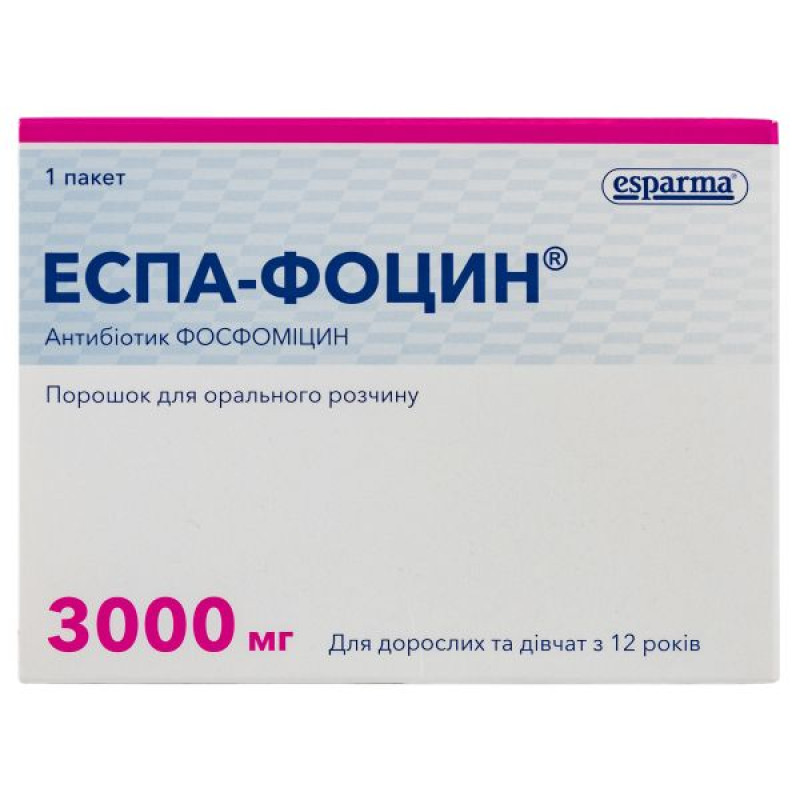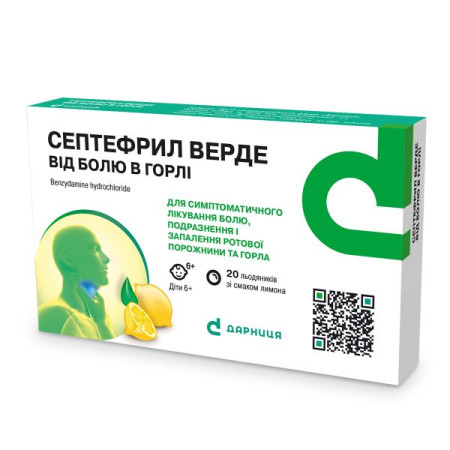Espa-Focin powder for oral solution 3000 mg, 8 g packet

Instructions Espa-Focin powder for preparation of solution for oral administration 3000 mg package 8 g
Composition
active ingredient: fosfomycin;
1 packet contains 5631.0 mg of fosfomycin trometamol, which is equivalent to 3000 mg of fosfomycin;
excipients: tangerine flavor, orange flavor, sodium saccharin, sucrose.
Dosage form
Powder for oral solution.
Main physicochemical properties: white or almost white granular powder, without foreign particles, fruity aroma, without foreign odors.
Pharmacotherapeutic group
Antimicrobial agents for systemic use.
ATX code J01X X01.
Pharmacological properties
Pharmacodynamics
Fosfomycin trometamol is a broad-spectrum antibiotic, a derivative of phosphonic acid. The mechanism of action is associated with blocking the first stage of bacterial cell wall synthesis. The specific mechanism of inhibition of enolpyruvyl transferase prevents the development of cross-resistance with other antibiotics.
Effective against gram-positive and gram-negative strains of microorganisms, including penicillase-synthesizing ones, and the main strains of pathogens of urinary tract infections: E. coli, Proteus, Klebsiella, Enterobacter, Staphylococcus, Streptococcus and other resistant strains.
Pharmacokinetics
ESPA-FOCIN® is well absorbed from the gastrointestinal tract. The maximum concentration in blood plasma (20–30 μg/ml) is reached 2–2.5 hours after administration. Therapeutic concentrations are maintained in urine for 48 hours.
Indication
Treatment of acute uncomplicated lower urinary tract infections caused by fosfomycin-susceptible microorganisms in adult patients and in girls aged 12 years and older. Prevention of infectious diseases during diagnostic procedures and surgical interventions in adult patients.
Contraindication
Hypersensitivity to the components of the drug, severe renal failure (creatinine clearance 10 ml/min), children under 12 years of age, undergoing hemodialysis.
Interaction with other medicinal products and other types of interactions
Concomitant administration with metoclopramide reduces the absorption of fosfomycin, which leads to a decrease in fosfomycin concentrations in serum and urine.
When the drug is taken with food, plasma and urine fosfomycin levels are reduced. Therefore, it is recommended to take the drug on an empty stomach or 2–3 hours after eating or taking other medications.
Specific problems with INR (international normalized ratio) fluctuations. Numerous cases of increased antivitamin K antagonist activity have been reported in patients taking antibiotics. Risk factors include serious infections or inflammation, advanced age, and poor general health. In these cases, it is difficult to determine whether the INR change is related to the infectious disease or to the drug. However, there are certain classes of antibiotics that are more commonly associated with INR fluctuations, including fluoroquinolones, macrolides, cyclines, cotrimoxazole, and some cephalosporins.
Interaction studies were conducted only with adults.
Application features
There is insufficient evidence of the effectiveness of fosfomycin in children, since the 3 g dosage is not intended for children under 12 years of age, the drug should not be used in this age group.
The use of broad-spectrum antibiotics, including fosfomycin trometamol, may lead to the development of antibiotic-associated colitis (including pseudomembranous colitis). Therefore, the possibility of this diagnosis should be considered in patients who develop severe diarrhea during or after taking fosfomycin trometamol. The severity can vary from mild diarrhea to fatal colitis. The occurrence of severe, persistent and/or bloody diarrhea during or after (including several weeks) the end of antibiotic treatment may be a symptom of Clostridium difficile-associated diarrhea (CDAD). If the diagnosis is confirmed, appropriate treatment should be started immediately. In this case, drugs that inhibit peristalsis are contraindicated.
Patients with diabetes and those who need to follow a diet should take into account that 1 packet of ESPA-FOCIN® contains 2.213 g of sucrose. The drug should also not be used in patients with fructose intolerance, glucose-galactose malabsorption and sucrose-isomaltase insufficiency.
A transient increase in hepatic transaminase activity is possible.
Clinical manifestations generally disappear on the 2nd or 3rd day of treatment. Sometimes certain symptoms may appear that do not indicate a lack of therapeutic effect, but are a consequence of inflammatory processes.
The use of fosfomycin may lead to the development of hypersensitivity reactions, including anaphylaxis and anaphylactic shock, which can be life-threatening (see section "Adverse reactions").
If these reactions develop, fosfomycin should be discontinued and re-administration of fosfomycin to these patients is unacceptable. Adequate therapeutic measures should be taken.
Renal insufficiency: Fosfomycin urinary concentrations remain therapeutically effective for 48 hours if creatinine clearance is above 10 mL/min.
Ability to influence reaction speed when driving vehicles or other mechanisms
Fosfomycin may cause dizziness, which may affect the ability to drive or operate machinery.
Use during pregnancy or breastfeeding
During pregnancy, the use of the drug is possible if necessary, when the expected effect of therapy for the mother outweighs the potential risk to the fetus.
Fosfomycin trometamol is not known to be teratogenic or fetotoxic. Animal studies have also shown no reproductive toxicity.
Do not use the drug during breastfeeding. Studies on use during breastfeeding have not been conducted.
Method of administration and doses
Take internally on an empty stomach. Dissolve the contents of the sachet in 125 ml (1/2 cup) of cold water, stir until completely dissolved and drink. The dosage is set individually by the doctor.
Usually, a single dose for adults (including elderly patients) and girls aged 12 years and older in the acute phase of the disease is 3 g of fosfomycin (1 packet) once.
To prevent urinary tract infections during surgical interventions and transurethral diagnostic studies, take 3 g of fosfomycin (1 packet) 3 hours before the intervention and 3 g of fosfomycin (1 packet) 24 hours after the intervention.
Children
Possible use for the treatment of acute uncomplicated lower urinary tract infections in girls aged 12 years and older.
There is insufficient data on the therapeutic use of the drug in boys aged 12 years and older, nor is there sufficient data on the prophylactic use of the drug in both boys and girls.
Overdose
Data on overdose of fosfomycin when administered orally are limited.
Symptoms: vestibular disorders, hearing loss, metallic taste in the mouth, and a general decrease in taste perception.
Cases of hypotension, severe drowsiness, electrolyte disturbances, thrombocytopenia, and hypoprothrombinemia have been reported with parenteral administration of fosfomycin.
Treatment: symptomatic and supportive therapy. It is recommended to drink plenty of fluids to increase diuresis.
Adverse reactions
The most common adverse reactions with a single dose of fosfomycin trometamol include gastrointestinal disturbances, mainly diarrhea. These phenomena are most often short-lived and resolve spontaneously.
The frequency of side effects is determined as follows:
very common (> 1/10);
often (> 1/100 - <1/10);
uncommon (> 1/1000 - <1/100);
rarely (> 1/10,000 - <1/1000);
very rare (<1/100,000);
unknown (cannot be determined from available data).
Within each frequency grouping, adverse reactions are presented in order of decreasing severity.
Adverse reactions and their frequency of development
| Organ system classes | ||||
| Often | Infrequently | Rarely | Unknown | |
| Infections and infestations | Vulvovaginitis | |||
| On the part of the immune system | Anaphylactic reactions including anaphylactic shock, hypersensitivity | |||
| From the nervous system | Headache, dizziness | Paresthesia | ||
| Cardiovascular system | Tachycardia | Arterial hypotension | ||
| Respiratory, thoracic and mediastinal disorders | Asthma | |||
| From the digestive system | Diarrhea, nausea, indigestion | Abdominal pain, vomiting | Pseudomembranous colitis | |
| Skin and subcutaneous tissue disorders | Rash, hives, itching | Angioedema | ||
| General disorders | Fatigue | |||
| From the vascular system | Hypotension |
Expiration date
2 years. The finished solution cannot be stored.
Storage conditions
Store in the original packaging at a temperature not exceeding 25 °C.
Packaging
8 g of powder (3000 mg of active ingredient) in a bag (paper-aluminum-polyethylene), 1 bag in a cardboard box.
Vacation category
According to the recipe.
Producer
Lindopharm GmbH.
Location of the manufacturer and its business address
Neustrasse 82, 40721 Gilden, Germany.
There are no reviews for this product.
There are no reviews for this product, be the first to leave your review.
No questions about this product, be the first and ask your question.












